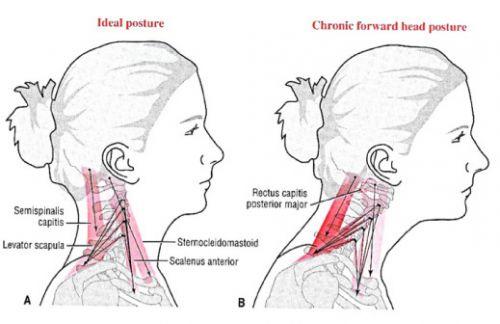Text Neck
Original Editor - Vidhu Sindwani
Top Contributors - Shoko Otsuka, Kim Jackson, Lucinda hampton, Vidhu Sindwani, Lauren Lopez, Rucha Gadgil and Kalyani Yajnanarayan
What is Text Neck?[edit | edit source]
The term “text neck” was introduced by a chiropractor in US.[1]
The definition of text neck is overuse syndrome, usually resulting from excessive strain on the neck from looking down at any handheld mobile device, which can lead to headaches, neck pain, shoulder and arm pain, breathing compromise.
The text neck posture during using hand-held mobile device is similar to the forward head posture, while the upper neck is held in flexion rather than extension.
There are many literatures on the association between using a mobile device and neck pain or symptoms which suggested the negative effects of text neck, however a majority of them have been concluded that existing evidence is limited.
The following studies have shown found no correlation between text neck and its symptoms assumed to occur:
Forward neck and neck pain/headache
· A study of over 1100 Australian teenagers found that despite higher rates of depression, forward head posture had no connection with neck pain or headaches.
· A study investigated the association between text neck and neck pain in adults and reported that the cervical flexion angle of the standing and sitting participant using a smartphone did not associate with the prevalence of neck pain, neck pain frequency, and maximum neck pain intensity.
· A systematic review found that forward head posture was significantly correlated with neck pain measures in adults, whilst no association was found between FHP and most of neck pain measures in adolescents.
Text neck and musculoskeletal symptoms
· A study investigated the associations of mobile touch screen device (MTSD) use with musculoskeletal symptoms and exposures, however there was limited evidence showing their associations.
The use of mobile devices is causing young people to sprout horns from their skulls
· Shahar and Sayers (2018) reported that the use of mobile devices is causing the development of prominent exostosis emanating from this enthesis in young adults.
This research gained widespread attention and was subject to significant criticism due to significant limitations and flaws, such as the source, size of the sample, and the ability to conclude about smartphone use from X-ray evidence.
Epidemiology[edit | edit source]
In 2023, reports estimate the total number of global smartphone users to reach 6.8 billion. Given the global population to reach just over 8 billion, 8 in 10 people will be equipped with a smartphone (85%)[2].
In America, the average time spent on a cellphone is 2 hours, 54 minutes, with 71% checking their phones within 10min of waking up.
Recent figures have shown that around 87% of teenagers (14-18 years) in USA and 79% teenagers (12-15 years) in UK own and use smartphones.
Among adults aged 18-34 years, 92% and 95% reported owing a smartphone in USA and Australia, respectively.[3]
Looking at the literature on the association between texting and neck pain, the answer is really muddled, because the studies that have been done on the topic are flawed.[4][3]. Scientific studies don’t appear in a vacuum; they are part of a growing body of evidence. To simply report on a single study is misleading.
Further trials and longitudinal research is needed to establish association between texting and neck pain and guidelines for use[3].
Mechanism of Injury / Pathological Process[edit | edit source]
Forward head dramatically increases the weight of the head on the spine, and the effect and amount of weight are powerfully and incrementally enhanced by varying degrees.
An average of cervical spine angle in flexion when texting is 37 to 47 degrees.
A study has shown that head weight increases to 18.14 kg at 30 degrees and 22.23 kg at 45 degrees
, and this can lead to inflammation of the ligaments, muscles, and nerves in the neck, resulting in permanent arthritic damage with increased curvature of the spine.[1]
A concern with children was raised due to their larger heads in relation to their body size than adults, thus they have an increased risk of potential damage on neck caused by text neck.[1]
Clinical Presentation of Text Neck[edit | edit source]
Damage caused by untreated text neck can be similar to occupational overuse syndrome or repetitive stress/strain injury.
A paper[1] proposed that the most common presentation of Text Neck is neck pain, stiffness and soreness. The main symptoms include:
- Stiff neck: soreness and difficulty in moving the neck is usually present when trying to move the neck after long usages
- Pain: can be localized to one spot or may be diffused over an area, usually lower part of the neck. Can be described as dull aching or can also be sharp or stabbing in extreme cases
- Radiating pain: there can often be radiation of pain into the shoulders and arms.
- Muscular weakness: shoulders muscles namely, trapezius, rhomboids and shoulder external rotators are often weak
- Headache: sub-occipital muscle tightness can lead to tension type headaches.
In addition to these common symptoms there can also be:
- Flattening of thoracic kyphosis
- Early onset arthritis
- Spinal degeneration
- Disc compression
- Muscle weakness
- Loss of lung capacity
Nevertheless, the symptoms indicated above were not given any supporting evidence in the article.[1]
- No evidence of the correlation between text neck and pain has not been found.
- Fiebert et al (2021) found the increased range of motion in cervical flexion after 10 minutes’ neck flexion and suggested the possibility of creep in the posterior ligaments of the spine due to forward head posture. This can affect the length-tension relationship of posterior cervical muscles and the stability provided by the posterior ligaments, and increasing in activation of erector spinae, which may result in disc herniation led by the abnormal movements between vertebral segments. However, this study measured only range of motion and amplitude of neck muscle after 10 mins’ cervical flexion, not a change in actual ligaments. Therefore, this hypothesis has not been proven.
Diagnostic Procedures[edit | edit source]
Full medical examination:
A complete medical history, including duration of electronic device usage and the onset of symptoms, must be collected prior to the medical examination. Pain should be assessed primally such as intensity, character, frequency and radiation to the neck or lower back.
Investigation:
After conducting a physical examination and collecting the patient's medical history, an X-ray can be advised. An X-ray of the neck shows curvature (usually curved backwards).
Management[edit | edit source]
Prevention is the key when it comes to Text Neck. The following recommendations from a systematic review[3] of Text Neck should be kept in mind while using smartphones or other hand held devices:
- Avoid excessive usage and take frequent breaks
- Avoid prolonged static postures
- Position the device such that it reduces stresses both on the head/neck and the upper extremities
- Avoid high repetitions of movements such as prolonged typing or swiping
- Avoid holding large or heavy devices in one hand for long duration
Rehabilitation is found to be very effective in treating the stress injury resulting from Text Neck. Rehabilitation can be designed as a 2-4 week program starting with soft tissue mobilization, Grade 1 and 2 joint mobilization, active and passive stretches of tight muscles and progressing to muscle strengthening, posture retraining and home exercise program.[5]
In acute cases, pain relief is the main goal. It can be achieved by:
- Regular neck movements: rotations and side bending
- Restoring function to upper trapezius and serratus[6]
- Chin tuck exercises
- Ice/heat packs
- Massage
In extreme chronic cases pain medication, injection into the facet joint or trigger point or acupuncture can be done.[1]
References[edit | edit source]
- ↑ 1.0 1.1 1.2 1.3 1.4 1.5 Neupane S, Ifthikar Ali UT, Mathew A. Text-Neck Syndrome-Systemic review. Imperial Journal of Interdisciplinary Research. 2017;3(7):141-148. Accessed 18 July 2019.
- ↑ Oberlo. How many people have smartphones in 2022. Available from https://www.oberlo.co.uk/statistics/how-many-people-have-smartphones (accessed 1 July 2022)
- ↑ 3.0 3.1 3.2 3.3 Toh SH, Coenen P, Howie EK, Straker LM. The associations of mobile touch screen device use with musculoskeletal symptoms and exposures: a systematic review. PLoS One 2017; 12(8): e0181220. Accessed 18 July 2019.
- ↑ McGill Text neck Available from: https://www.mcgill.ca/oss/article/technology-general-science/text-neck-epidemic-truly-over ( accessed 21.3.2021)
- ↑ Sharan D, Mohandoss M, Ranganathan R, Jose J. Musculoskeletal disorders of upper extremities due to extensive usage of hand held devices. Annals of Ann Occup Environ Med. 2014; 26(22). Accessed 18 July 2019.
- ↑ Kwon JW, Son SM, Lee NK. Changes in upper-extremity muscle activities due to head position in subjects with a forward head posture and rounded shoulders. J Phys Ther Sci. 2015. 27; 6:1739–1742. Accessed 18 July 2019.









